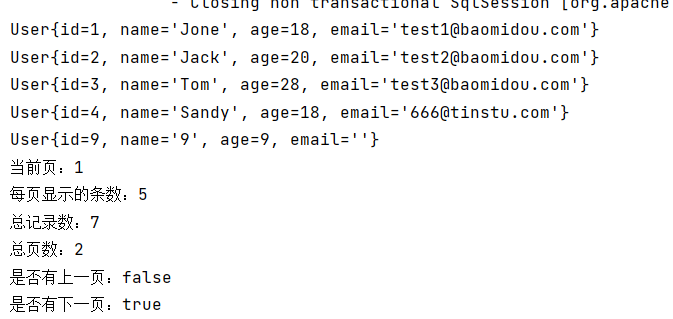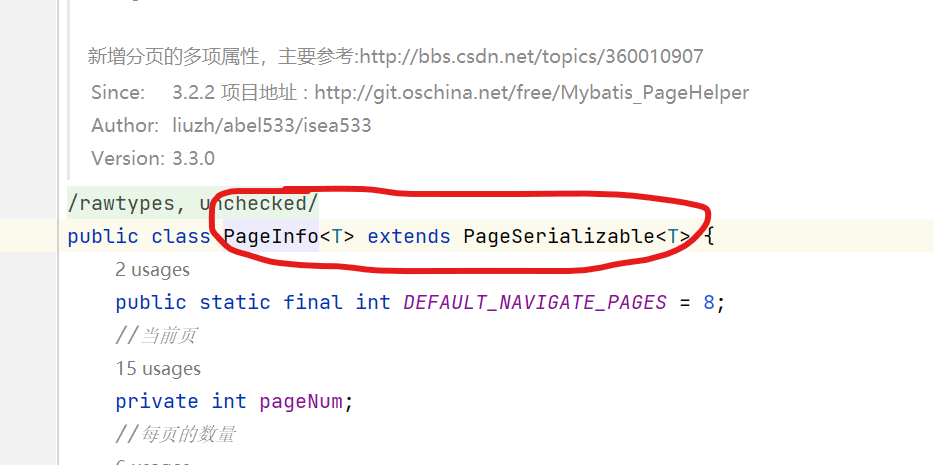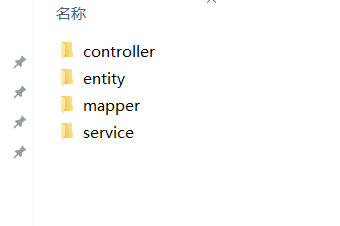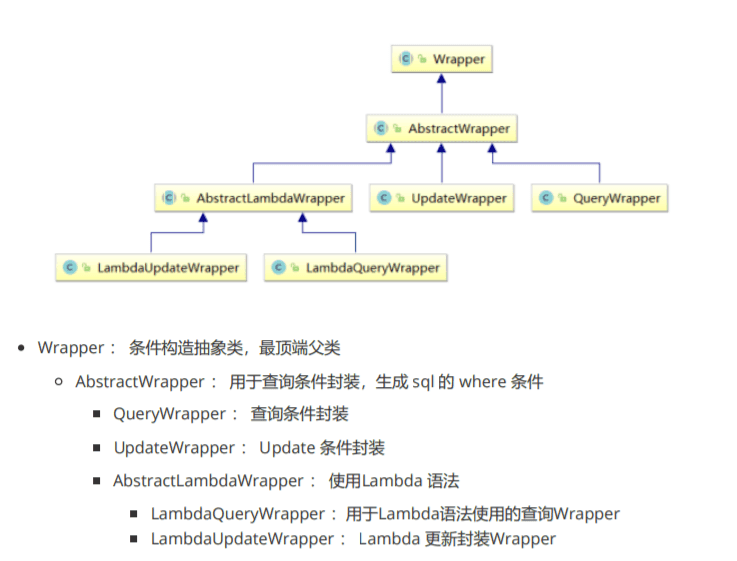MyBatisPlus:插件
分页插件:
添加配置
<!-- 此处使用的是MybatisSqlSessionFactoryBean -->
<bean class="com.baomidou.mybatisplus.extension.spring.MybatisSqlSessionFactoryBean">
<!-- 设置MyBatis配置文件的路径(可以不设置) -->
<property name="configLocation" value="classpath:mybatis-config.xml"></property>
<!-- 设置数据源 -->
<property name="dataSource" ref="dataSource"></property>
<!-- 设置类型别名所对应的包 -->
<property name="typeAliasesPackage" value="com.tinstu.pojo"></property>
<property name="globalConfig" ref="globalConfig"></property>
<!--配置插件-->
<property name="plugins">
<array>
<ref bean="mybatisPlusInterceptor"></ref>
</array>
</property>
</bean>
<!--配置MyBatis-Plus插件-->
<bean id="mybatisPlusInterceptor"
class="com.baomidou.mybatisplus.extension.plugins.MybatisPlusInterceptor">
<property name="interceptors">
<list>
<ref bean="paginationInnerInterceptor"></ref>
</list>
</property>
</bean>
<!--配置MyBatis-Plus分页插件的bean-->
<bean id="paginationInnerInterceptor"
class="com.baomidou.mybatisplus.extension.plugins.inner.PaginationInnerInterceptor">
<!--设置数据库类型-->
<property name="dbType" value="MYSQL"></property>
</bean>测试:
@Test
public void testPage(){
//设置分页参数
Page<User> page = new Page<>(1, 5);
usermapperP.selectPage(page, null);
//获取分页数据
List<User> list = page.getRecords();
list.forEach(System.out::println);
System.out.println("当前页:"+page.getCurrent());
System.out.println("每页显示的条数:"+page.getSize());
System.out.println("总记录数:"+page.getTotal());
System.out.println("总页数:"+page.getPages());
System.out.println("是否有上一页:"+page.hasPrevious());
System.out.println("是否有下一页:"+page.hasNext());
}
xml自定义分页
UserMapper.java中定义接口方法
/**
* 根据年龄查询用户列表,分页显示
* @param page 分页对象,xml中可以从里面进行取值,传递参数 Page 即自动分页,必须放在第一位
* @param age 年龄
* @return
*/
IPage<User> selectPageVo(@Param("page") Page<User> page, @Param("age") Integer age);UserMapper.xml中编写Sql
<!--IPage<User> selectPageVo(Page<User> page, Integer age);-->
<select id="selectPageVo" resultType="User">
SELECT
<include refid="Base"></include>
FROM t_user WHERE age > #{age}
</select>测试
@Test
public void testSelectPageVo(){
//设置分页参数
Page<User> page = new Page<>(1, 5);
userMapper.selectPageVo(page, 20);
//获取分页数据
List<User> list = page.getRecords();
list.forEach(System.out::println);
System.out.println("当前页:"+page.getCurrent());
System.out.println("每页显示的条数:"+page.getSize());
System.out.println("总记录数:"+page.getTotal());
System.out.println("总页数:"+page.getPages());
System.out.println("是否有上一页:"+page.hasPrevious());
System.out.println("是否有下一页:"+page.hasNext());
}
乐观锁
1.场景
一件商品,成本价是80元,售价是100元。老板先是通知小李,说你去把商品价格增加50元。小李正在玩游戏,耽搁了一个小时。正好一个小时后,老板觉得商品价格增加到150元,价格太高,可能会影响销量。又通知小王,你把商品价格降低30元。此时,小李和小王同时操作商品后台系统。小李操作的时候,系统先取出商品价格100元;小王也在操作,取出的商品价格也是100元。小李将价格加了50元,并将100+50=150元存入了数据库;小王将商品减了30元,并将100-30=70元存入了数据库。是的,如果没有锁,小李的操作就完全被小王的覆盖了。现在商品价格是70元,比成本价低10元。几分钟后,这个商品很快出售了1千多件商品,老板亏1
万多。
乐观锁与悲观锁
上面的故事,如果是乐观锁,小王保存价格前,会检查下价格是否被人修改过了。如果被修改过了,则重新取出的被修改后的价格,150元,这样他会将120元存入数据库。如果是悲观锁,小李取出数据后,小王只能等小李操作完之后,才能对价格进行操作,也会保证最终的价格是120元。
模拟修改冲突
数据库创建表并添加数据
CREATE TABLE t_product
(
id BIGINT(20) NOT NULL COMMENT '主键ID',
NAME VARCHAR(30) NULL DEFAULT NULL COMMENT '商品名称',
price INT(11) DEFAULT 0 COMMENT '价格',
VERSION INT(11) DEFAULT 0 COMMENT '乐观锁版本号',
PRIMARY KEY (id)
);
INSERT INTO t_product (id, NAME, price) VALUES (1, '外星人笔记本', 100);添加实体类
@Data
@TableName("t_product")
public class Product {
private Long id;
private String name;
private Integer price;
private Integer version;
}
测试:
@Test
public void testConcurrentUpdate() {
//1、小李
Product p1 = productMapper.selectById(1L);
System.out.println("小李取出的价格:" + p1.getPrice());
//2、小王
Product p2 = productMapper.selectById(1L);
System.out.println("小王取出的价格:" + p2.getPrice());
//3、小李将价格加了50元,存入了数据库
p1.setPrice(p1.getPrice() + 50);
int result1 = productMapper.updateById(p1);
System.out.println("小李修改结果:" + result1);
//4、小王将商品减了30元,存入了数据库
p2.setPrice(p2.getPrice() - 30);
int result2 = productMapper.updateById(p2);
System.out.println("小王修改结果:" + result2);
//最后的结果
Product p3 = productMapper.selectById(1L);
//价格覆盖,最后的结果:70
System.out.println("最后的结果:" + p3.getPrice());
}乐观锁实现流程
数据库中添加version字段
取出记录时,获取当前version
SELECT id,`name`,price,`version` FROM product WHERE id=1更新时,version + 1,如果where语句中的version版本不对,则更新失败
UPDATE product SET price=price+50, `version`=`version` + 1 WHERE id=1 AND `version`=1
Mybatis-Plus实现乐观锁
@Data
@TableName("t_product")
public class Product {
private Long id;
private String name;
private Integer price;
@Version
private Integer version;
}添加乐观锁插件配置
<!--配置MyBatis-Plus插件-->
<bean id="mybatisPlusInterceptor"
class="com.baomidou.mybatisplus.extension.plugins.MybatisPlusInterceptor">
<property name="interceptors">
<list>
<ref bean="paginationInnerInterceptor"></ref>
<ref bean="optimisticLockerInnerInterceptor"></ref>
</list>
</property>
</bean>
<!--设置数据库类型-->
<property name="dbType" value="MYSQL"></property>
</bean>
<!--配置乐观锁插件-->
<bean id="optimisticLockerInnerInterceptor"
class="com.baomidou.mybatisplus.extension.plugins.inner.OptimisticLockerInnerInterceptor"></bean>test
@Test
public void testConcurrentVersionUpdate() {
//小李取数据
Product p1 = productMapper.selectById(1L);
//小王取数据
Product p2 = productMapper.selectById(1L);
//小李修改 + 50
p1.setPrice(p1.getPrice() + 50);
int result1 = productMapper.updateById(p1);
System.out.println("小李修改的结果:" + result1);
//小王修改 - 30
p2.setPrice(p2.getPrice() - 30);
int result2 = productMapper.updateById(p2);
System.out.println("小王修改的结果:" + result2);
if(result2 == 0){
//失败重试,重新获取version并更新
p2 = productMapper.selectById(1L);
p2.setPrice(p2.getPrice() - 30);
result2 = productMapper.updateById(p2);
}
System.out.println("小王修改重试的结果:" + result2);
//老板看价格
Product p3 = productMapper.selectById(1L);
System.out.println("老板看价格:" + p3.getPrice());
}最终结果为120!
阅读剩余
版权声明:
作者:Tin
链接:http://www.tinstu.com/1482.html
文章版权归作者所有,未经允许请勿转载。
THE END



